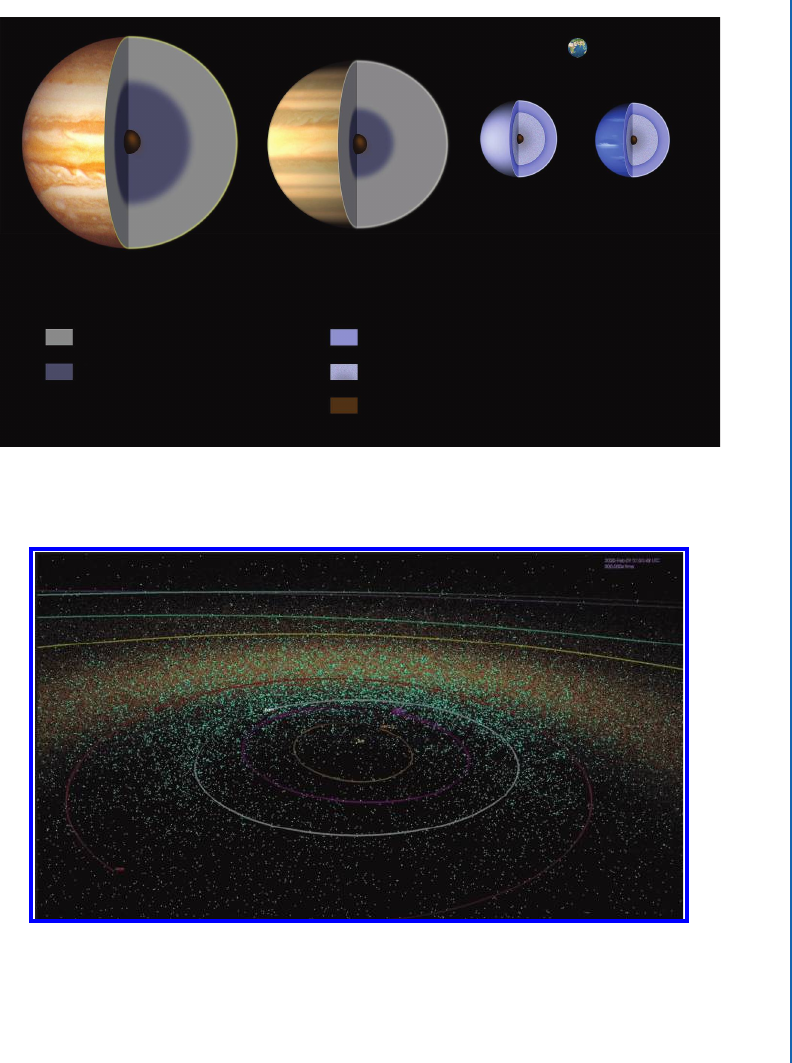
105
C H A P T E R 8
Evolution of the Solar System
8.1 COMPONENTS OF THE SOLAR SYSTEM
e Sun formed about 4.6 billion years ago, and the basic layout of the rest of the solar system
formed in that same context. We have already described the sizes and distances to what have
historically been called planets, but there are other important types of objects too.
is begs an obvious question. How do we decide whether or not something “belongs
to” the solar system? is may seem an arbitrary decision. But there is a specific answer that
makes sense: objects in the solar system are gravitationally bound to the Sun. is means that
solar system objects perenially orbit the Sun, and so cannot escape its gravity.
Even this sensible definition has its limits; objects at the fringes of the solar system are
only weakly bound to the Sun, and so they can be captured by nearby stars. at caveat aside, I
briefly describe in Section 8.1 the most significant parts of the solar system.
8.1.1 TERRESTRIAL PLANETS
e terrestrial (Earthlike) planets are Mercury, Venus, Earth, and Mars. ey have many prop-
erties in common that are distinct from those of the Jovian planets described in Section 8.1.2.
e terrestrial planets are relatively small and have comparatively high average densities, con-
sistent with a composition of rock and metal.
Earth is largest, with Venus not far behind. Mars and Mercury are considerably smaller,
with Mercury only 50% larger than Earth’s (only) satellite, the Moon. See Figure 8.1 for images
made to scale.
Figure 8.1 depicts an Earth telescope view of Mars, but the other three planets are por-
trayed with imagery from the space program. e picture of Venus is not a picture—it is an
elevation map of the surface made with radar from an orbiting space probe; the orange color
was chosen arbitrarily, and is not meaningful. Venus has a dense, opaque atmosphere, and only
radar can peer through the relatively featureless clouds.
e terrestrial planets have relatively few satellites. Earth has its very-large Moon, and
Mars has two tiny satellites; Venus and Mercury have none.
8.1.2 JOVIAN PLANETS
e Jovian planets are Jupiter, Saturn, Uranus, and Neptune. ey are very much larger than
the terrestrial planets. e smallest, Neptune (Uranus is only slightly larger), has nearly 4 times

106 8. EVOLUTION OF THE SOLAR SYSTEM
Figure 8.1: e terrestrial planets, portrayed to scale. From left to right: Mercury, Venus, Earth,
and Mars. (Image credit: NASA/JPL/HST/Mercury Globe-MESSENGER, Public Domain.)
the diameter, roughly 60 times the volume, and over 17 times the mass of Earth. Jupiter, the
largest, is 11 times Earth’s diameter, has over 1400 times its volume, and over 300 times Earth’s
mass. But the average densities of the Jovian planets are much lower than those of the terrestrial
planets. Jupiter, for example, has a density less than 1/4 that of Earth. Saturn is less dense, on
average, even than water.
is means the Jovian planets must be made primarily of the lightest of elements. e
largest, Jupiter and Saturn, are made primarily of the two lightest elements, hydrogen and he-
lium. See Figure 8.2 for a to-scale depiction of the interiors of the Jovian planets. ey are
compressed by gravity to a liquid, except for the outermost atmospheric layer of gases. ere
is likely a (relatively) small core of rock and ice. Uranus and Neptune are slightly denser, with
greater proportions of rock and ice compared to hydrogen and helium.
8.1.3 ASTEROIDS
e asteroids are small, mostly rocky bodies that have many different orbits, but the majority lie
between Mars and Jupiter in what is known as the asteroid belt. See Figure 8.3 for a graphical
depiction of the orbits of many thousands of known asteroids. e bright white marked orbit is
that of Earth, and it is clear that most lie in the asteroid belt between Mars and Jupiter.
e caption of Figure 8.3 contains a link to an animation of these orbits, showing that they
do progress all in the same sense, and this is the sense of orbits in the solar system in general.
But close inspection shows that the asteroids form a thick torus of orbits, and those of many are
inclined at least several degrees to the plane of the rest of the solar system.

8.1. COMPONENTS OF THE SOLAR SYSTEM 107
Earth
Jupiter Saturn Uranus Neptune
Molecular Hydrogen
Metallic Hydrogen
Hydrogen, Helium, Methane Gas
Mantle (water, ammonia, methane ices)
Core (rock, ice)
Figure 8.2: e Jovian planets shown to scale, with their interior structures. Earth is shown to
scale for comparison. (Graphic credit: Lunar and Planetary Institute, Public Domain.)
Figure 8.3: e plotted orbits of many thousands of asteroids. e white orbit is that of Earth;
most of the asteroids are in the belt between the orbits of Mars and Jupiter. Possible Earth-
crossing asteroids are shown in blue. Video of asteroid orbits, with near-Earth asteroids high-
lighted. (Image credit: NASA/JPL-Caltech.)

108 8. EVOLUTION OF THE SOLAR SYSTEM
Figure 8.4: e asteroid Mathilde. It is about 50 km across. (NASA, Public Domain.)
e asteroids highlighted in green in the animation are dubbed near-Earth asteroids. eir
orbits potentially could cross that of Earth’s, and so there is at least a slight risk of collision (albeit
far in the future).
e largest asteroid is Ceres, at about 950 km in diameter. e second-largest is Vesta,
only a bit more than half that size. All of the rest are too small for gravity to pull them into
spheres, and so they are essentially random shapes. Some asteroids have been visited with space
probes. See Figure 8.4 for a close-up image of one.
8.1.4 OORT CLOUD COMETS
Most comets are small (only several kilometers in diameter), mostly icy bodies that spend the
bulk of their time too far from the Sun to be seen. e largest reservoir of these bodies is far
beyond the orbits of the planets, nearly one fourth of the distance to the nearest star. is mostly
spherical shell of cometary objects is called the Oort cloud.
e Oort cloud cannot be seen directly; its existence is inferred by modeling the interac-
tion of icy bodies with the newly-formed Jovian planets in the early solar system, and by studying
the orbital dynamics of the many individual comets we do see. For comets are only visible if they
come relatively close to the Sun, which then vaporizes some of the ices on their surfaces, forming
a large and visible glowing cloud around the tiny nucleus. is process sometimes also releases
dust, which reflects sunlight.
On the occasion that a comet does come to the inner solar system, the large cloud of
gas and dust released by the Sun’s radiation is sometimes easily visible to the naked eye. See
Figure 8.5 for an example—comet Hale–Bopp that graced the skies in 1997.

8.1. COMPONENTS OF THE SOLAR SYSTEM 109
Figure 8.5: Comet Hale-Bopp as photographed with a small telescope. e stars in the back-
ground appear as short streaks because the telescope was tracked instead on the tiny nucleus of
the comet. It’s orbital motion about the Sun is apparent even over the course of this 30-min
exposure. Photograph by the author.
Oort cloud comets have plunging orbits that can come from any direction; their orbits are
often not at all aligned with the plane of the solar system. ey quickly swing around the Sun and
are never seen again. ese comets, with their highly elongated orbits, spend the overwhelming
majority of their time moving slowly, very far from the Sun.
8.1.5 PERIODIC COMETS
A small minority of comets have orbits that are relatively small—with periods from several years
to several hundred years. And so we see such a comet repeatedly throughout human history.
Most of these short-period comets have very elongated orbits, that take them to the outer planets
or even beyond.
Comet Halley is a good example, with its orbital period of roughly 76 years. For the vast
majority of that time, it is too far away for the Sun to evaporate a visible cloud of gas and dust
around it. But its highly elliptical orbit brings it periodically close to Earth and the Sun, and
we get a spectacular view. See Figure 8.6 for one of the few close-up images of the nucleus of a
comet, taken from the Deep Impact space probe.
Regarding periodic comets, however, Halley is the exception. Most are far from spectac-
ular to the naked eye, with most only visible in telescopes, even when at their brightest.
..................Content has been hidden....................
You can't read the all page of ebook, please click here login for view all page.
